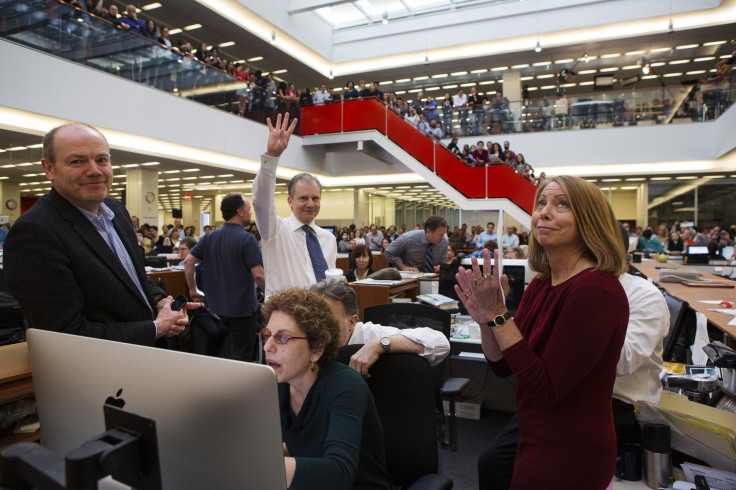Jill Abramson’s Firing Felt Deeply Among Women Journalists: ‘We’re Back To Square One’

One step forward, two steps back?
The sudden firing of New York Times executive editor Jill Abramson this week dismayed many women journalists and prompted speculation about what role gender may have played in her abrupt dismissal.
“She has been held up as this stalwart example of women’s ability to break the glass ceiling,” Elisa Lees Munoz, executive director of the International Women’s Media Foundation, told International Business Times. “Her departure from that role brings us back to square one, which is not a happy place for women in the news media.”
Abramson, who lasted less than three years as the Times’ top editor, was the first woman ever to hold that position. Her appointment in 2011 was considered a “big victory in the face of a big void,” wrote Poynter’s Jill Geisler: a move that could change the way “old-school publishers” thought about staffing their newsrooms and corner offices.
Her ouster undid much of the sense of victory that was felt at her appointment.
“I think we can worry now about whether [gender parity] will still be a priority for the New York Times,” Munoz said, pointing to a recent study conducted by the Women’s Media Center that showed just 31 percent of the Times’ bylined stories were crafted by women.
Times journalists in the Wednesday meeting where Abramson’s firing was announced said that two top editors, national editor Alison Mitchell and assistant managing editor Susan Chira, told publisher Arthur Sulzberger that Abramson’s ouster would be disconcerting for other female journalists at the paper.
“Among the women here, there was a deep appreciation that another woman was high up at the Times. It symbolically had an impact,” a female staffer told Slate’s Amanda Hess. The same article also mentioned how, upon Abramson’s appointment as executive editor, junior female staffers formed an “Old Girls Club” where they would meet on occasion for after-work happy hours to build relationships. On at least one occasion, they invited Abramson to join, and she did.
“It was awe-inspiring, the way she took that time out of her life to powwow with us, without ever seeming ceremonial about it,” one female staffer said.
In Abramson’s first address to the Times staff as executive editor, she credited “my sisters,” naming more than a dozen women at the newspaper who had helped her along the way. She in turn promoted several women to senior positions, including Chira, and named Margaret Sullivan as public editor. In the statement she issued after being dismissed, she cited her mentorship of other women as one of her accomplishments.
“She was not somebody who wanted to be the only woman in the boys’ club,” said Barbara Cochran, the Curtis B. Hurley Chair in Public Affairs Journalism at the Missouri School of Journalism. “She was someone who wanted to collaborate with other women and bring other women along.”
A New Yorker article saying Abramson was fired partly because she had complained about a pay discrepancy lit up social media in the hours after her dismissal, and the Times moved quickly to quash the report, emphatically denying that Abramson had been paid less than her male predecessor.
That left open the question of why, exactly, she was pushed out. The explanations tended to land on sensitive issues of gender expectations and stereotypes.
Numerous reports, including one by the Times, characterized Abramson as “mercurial” and polarizing. Many observers cited a 2013 Politico article that described a fight between Abramson and her now-successor, Dean Baquet. Though Baquet was the one who punched a wall, the thrust of the story, which Abramson admitted made her cry, was about her unpopularity in the newsroom.
“What’s so disheartening about it is that it became all about her personality,” Cochran said.
Criticism of Abramson’s managerial style is hardly unusual for women in leadership positions, Munoz said. Some research has shown that certain behavior is more poorly received when exhibited by a woman than a man.
“I think it’s natural for all of us to assume that some of those cultural reactions were playing out in the newsroom as well,” Munoz said.
“To me it seems that women are put in a position that if you’re collaborative and a consensus-builder, you’re considered too soft,” Cochran said, “and if you’re demanding and hard-charging, you’re considered too tough.”
“Jill really was a role model and beacon of hope for women that they could rise not just to the levels near the top but to the very top,” Cochran said.
It’s not yet clear whether, in order to remain at the top, women still have to meet different expectations than men do.
© Copyright IBTimes 2024. All rights reserved.






















